Ελληνικό Ινστιτούτο Εποικοδομητικής Δημοσιογραφίας
What is the benefit when the news is driven by a thirst for blood, terrifying headlines, and the cynical idea that the world will never get any better?
Journalism, as the cornerstone of public information, is in deep crisis. For at least two decades now, the industry has been fighting on two fronts: on the one hand, a constant decline in revenue, and on the other, the growing distrust of the public towards it. Communication experts who study this situation (academics, journalists, organizations and others) have long been sounding the alarm, searching for ways to transform it so that it can respond to the challenges of the modern era. Yet the truth is that, as a system, it fails to fulfill its fundamental role: to inform responsibly, to deepen the understanding of the world, and to encourage citizens’ participation.
Of course, there have been — and still are — many important and excellent pieces of journalism. But the news media as a whole, as a profession and a public service, is not doing well. It remains trapped in a mindset that prioritizes drama, fear, and confusion instead of information, analysis, and solutions. This failure is not merely a professional issue for journalists. It is a profound social crisis that affects democracy, trust in institutions, and the general psychological state of citizens.
However, there is an alternative. A different model of journalism that does not feed only anxiety and pessimism, but also offers perspective, understanding, and hope. Even though, apparently, out of inertia and habit, many professionals in the field are unable to realise it, process it, and change their practices. This is Constructive Journalism, an approach that does not avoid difficult topics but also highlights solutions, promoting knowledge and action instead of paralysis and cynicism. And this approach is not just an idealistic utopia — it is a matter of survival, both for the media and for democracy itself.
But before we focus on the “treatment,” let’s first understand the “disease.” How did we get here? How did journalism, once a guardian of truth, end up reinforcing the sense of deadlock? And who ultimately benefits from this situation?
The Current Situation
The crises of recent years have caught most people off guard, including those working in what we generally call the “Press.” From the 2008 financial crisis, the pandemic, the climate crisis, the wars in Ukraine and the Middle East, to the global questioning of liberal democracies. Although journalism has the role of analysis and foresight, journalists often appear unaware of the deeper causes of these developments — and even more so of their own responsibility in how they have been portrayed. For example, we experienced the wave of populism that spread during the economic crisis of the past decade in our country — and beyond. In 2016, an impersonal political movement emerged from unfulfilled hopes and expectations, peaking in the United States with Donald Trump’s election to the presidency and in Europe with Brexit. All completely “unexpected” for many in the media industry, even though the accumulated social discontent was clearly visible. And so it continues to this day with Trump’s re-election (see the study we presented on the media’s responsibility in covering the recent US presidential elections). In all these cases, the media ignored or underestimated citizens’ frustration, following a narrative that confirmed their own biases instead of recording the complexity of reality.
A striking example of journalism’s failure to respond to the challenges of our time is the issue of climate change and the loss of biodiversity due to human responsibility. The most significant historical change, which began in the last century, was for years covered superficially by many news outlets. The public debate on climate was flooded with misleading narratives, where scientifically unfounded opinions were presented as a “counterargument” to the well-documented warnings of the scientific community. This false equivalence — the idea that “both sides have a point,” even when one side is not based on scientific facts — undermined public understanding and delayed meaningful action.
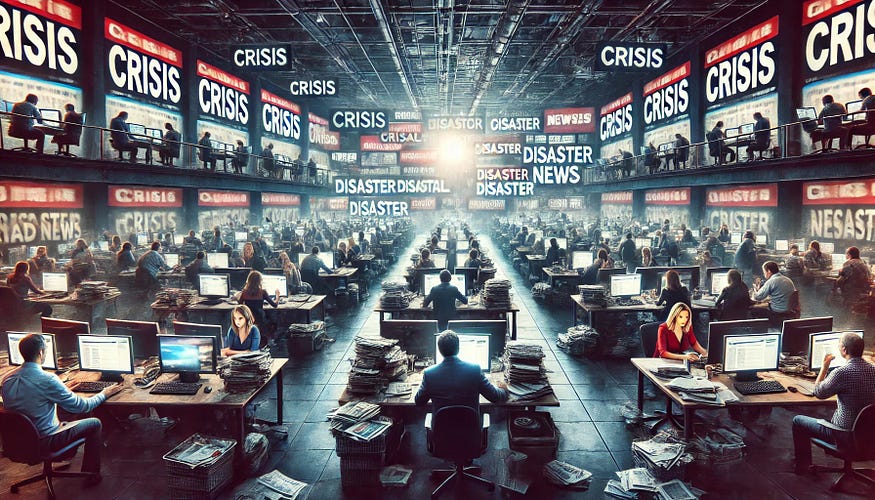
– Stagnation in the Face of Change
Journalism, which is supposed to be dedicated to seeking what is new and important, has remained trapped in old practices. The preference for drama, flashy headlines, and sensational coverage prevented the media from recognising and highlighting gradual but critical social changes. The paradox is that while the press claims to be “critical,” it has failed in precisely that fundamental role.
Being critical does not mean tearing everything down indiscriminately. True criticism requires deeper understanding and the ability to see the bigger picture.
In recent years, many journalists have been forced to admit that the kind of journalism they learned is not enough to address the major challenges of our time. Some of them are pioneering in the field of Constructive Journalism, which we will examine next. But for most, this realisation has not yet led to a clear and mature proposal about what kind of journalism is best suited to be taught to the next generations of journalists. This question remains open and continues to trouble editors and journalists worldwide. This uncertainty is reflected in the annual International Journalism Conferences, where in recent years the programmes consist almost exclusively of various versions of “collective introspection.” Despite the interesting and thought-provoking discussions, there are still many in the “established” press who insist that the “product” is just fine as it is. They refuse to critically reconsider what it means to be a journalist, what the role of information is, and what the social responsibility of the profession should be.
– An Obsession with Negativity
In newsroom editorial meetings, five basic criteria dominate news selection: significance, relevance, impact, timeliness, and conflict. These criteria, with slight variations, continue to be taught in most journalism schools and guide daily news coverage. However, already back in 1965, the late Norwegian sociologist Johan Galtung — one of the founders of Peace and Conflict Studies — had warned about the consequences of this approach. Although he analysed how the media filter the news, his findings were not used as a warning but as a “manual” for how news should operate. As he said in an interview: “I was describing what the news media were doing and warning against that way of filtering the world. But they thought they understood everything, so they used my research to describe what they should do instead of what they shouldn’t. And the consequences ever since have been many…”
Nevertheless, “negative reporting” continues to dominate, as most news directors see it as the recipe for success.
Constant exposure to negative news has been linked to higher levels of anxiety, depression, and psychological fatigue. Studies (as the late Professor of Positive Psychology Anastasios Stalikas characteristically explained) show that phenomena such as “bad news fatigue” and “news avoidance” have become commonplace for more and more citizens worldwide. People, feeling bombarded by problems they cannot control, often withdraw, lose trust, and become unwilling to engage in public life. Moreover, this obsession with negativity creates a distorted image of reality. The world is full of challenges, but it is also full of solutions, progress, and stories of hope. When the focus is exclusively on problems, the creativity and resilience that define human nature are overlooked.
News avoidance is a problem for traditional media outlets. News organizations need readers, listeners, or viewers to generate advertising revenue, sell subscriptions, and maintain their social relevance. But news avoidance is also a problem for democracy itself…
Despite an abundance of research showing the opposite, the idea persists that a good story must contain these criteria. And they still insist that “bad news sells” (the well-known if it bleeds, it leads). Journalists continue to wear the term “bloodthirsty” as a badge of honor, while some insist on claiming that every person in a position of power is by definition foolish or corrupt (a synonym for evil).
The negativity bias has become so deeply rooted that many in the media refuse to consider the possibility of change. “There’s no reason to change. The problem is society, not us,” is one of the most common excuses. But this “product” no longer sells. Audiences are declining and trust in journalism is collapsing. So perhaps this insistence on this model of news is part of the problem itself?
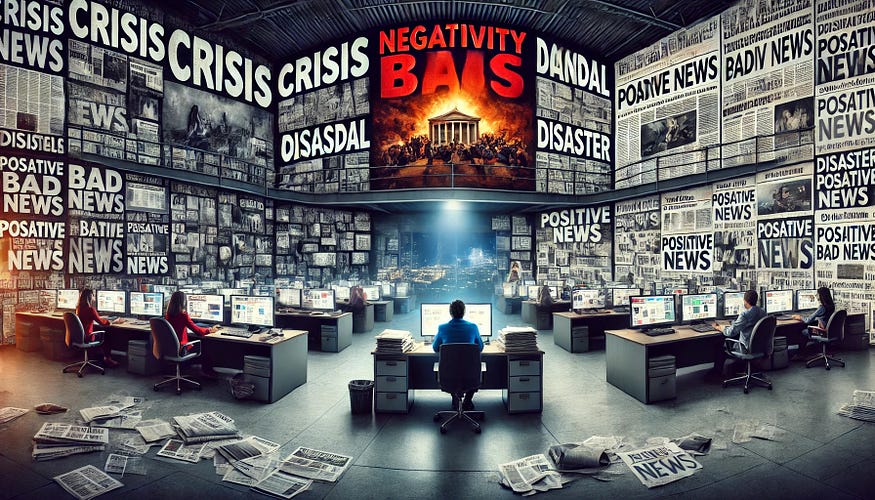
Who’s to Blame?
Let’s take a break and imagine ourselves in the position of a company’s CEO. We have a top-tier workforce, and we take pride in delivering a quality product to our customers.
But what would happen if one day this product stopped satisfying the public? If it had lost its quality or if customer preferences had changed? How would we react if our customers started to complain? Would we continue production without changing anything? Would we insist that our product is top-notch and that the problem lies in how consumers use it? Or would we do the obvious: examine our product critically, identify our mistakes, and look for ways to adapt it to meet new needs?
Most logically thinking people would choose the last option. Yet in journalism, the first approach seems to prevail. Instead of self-criticism, media insist that the audience is to blame — that it “isn’t interested,” “doesn’t understand,” or “doesn’t know what it wants.” Don’t these “logical” responses in this field seem like a mystery of absurdity?
– Cynicism and Levelling
What should we call the mindset at the root of this “logic” that it’s the “customers” and not the “product” that are to blame? Let’s call it “the art of cynicism,” and in what follows, we argue that it is not only useless but also shallow and manipulative if journalism’s purpose is truly to describe reality.
The Roman statesman and philosopher Cicero believed that to solve a crime, you must ask Cui bono? — “Who benefits?” Who, in other words, profits from a given situation?
Let’s ask the same question in journalism: Who benefits from a press that assumes everyone has something to hide? That presents everyone as guilty until proven innocent? That is driven by the belief that the best stories are the dramatic deviations from the norm — the destruction, the absurd, the embarrassing, the strange?
Many in the journalism field would answer that this cynical approach benefits society. It benefits democracy. In a democratic system, it is necessary for the powerful to be monitored and held accountable for their actions, and thus, journalism must act as the unofficial “fourth estate,” alongside the three institutional ones — the executive, the legislative, and the judiciary.
Undoubtedly, good journalism must shine a light into the dark corners of power. However, the journalistic “art of cynicism” mistakenly assumes that the only way to expose the “bad guys” is to suspect everyone.
In this way, the cynic equates criticism with cynicism itself. They constantly cast a wide net hoping to catch something. In the worst cases, minor mistakes are blown out of proportion, a simple statement turns into a scandal, and politicians and others, afraid of saying something that might be misinterpreted, resort to empty, formulaic answers, fearful that one slip could put them in the crosshairs. And when everyone is thrown into the fire in the same way, it becomes difficult to distinguish the truly “bad guys” from people who may have simply made a mistake…
Yet indiscriminate distrust is not criticism. When everyone is treated as guilty, criticism turns into accusation, and journalism loses its credibility.
Constant suspicion, when it becomes an end in itself, does not serve the truth — it distorts it. It creates a culture of fear, where politics and public life become a constant arena of accusations and conflict. This has serious consequences for society too: citizens, exposed to a relentless stream of pessimism and scandal-mongering, gradually lose trust not only in the media but in institutions altogether.
Thus, the belief takes root that everyone is a liar, that the powerful care only about their own interests, that no one is worthy of trust. People begin to see “evil” everywhere and believe that things are always getting worse — even when the data says otherwise.
Ultimately, this culture drives people away from news altogether. They see it as depressing, excessively negative, hopeless. And as trust in traditional media collapses, they turn to alternative sources of information (social media, etc.) — many of which are full of misinformation, fake news, and conspiracy theories.
As the late professor of global health Hans Rosling used to say: “There is no room for data when our mind is occupied by fear.”
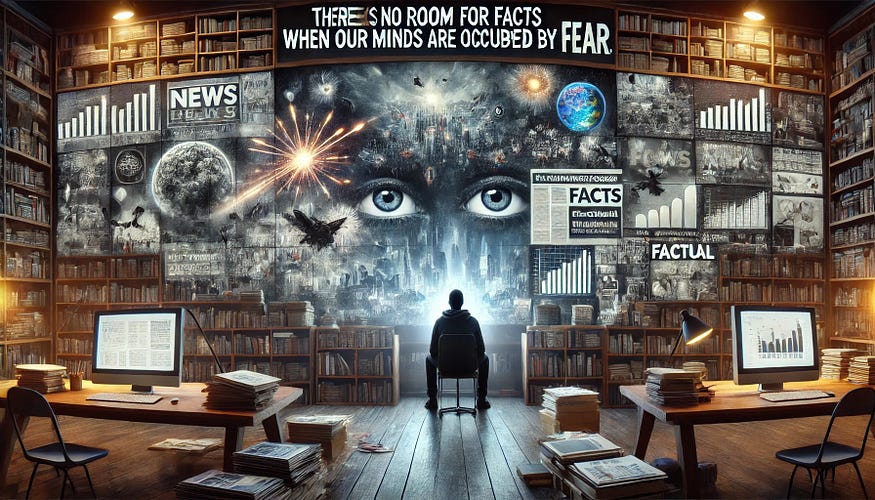
– The Erosion of Trust
And so we come to the sad consequences of all this: public trust in the media is at its lowest point ever. The cynicism of the media and its distorting focus on negativity have created an imbalanced, self-serving, and often misleading picture of the world. The result is an ever-widening gap between reality and what people believe is happening.
Citizens around the world are becoming increasingly distrustful of the news. In Greece, the percentage of people who do not trust the media reaches nearly 80% — one of the highest among all countries, according to recent research by the Reuters Institute at the University of Oxford.
Particularly concerning is that the new generations — tomorrow’s audience for journalism — express their dissatisfaction even more strongly. As another study highlights (How Young People Consume News and The Implications for Mainstream Media), young people believe that the media focus excessively on the negative. They feel that violence, hatred, and crime receive far more attention than positive change. They also believe that people in public life are often attacked unfairly, while radical views are overly amplified in the name of what the media call “impartiality” and “balance.”
The crisis of trust in the media is not just a problem for the public — it’s a problem for the news industry itself. Does this atmosphere of suspicion and cynicism benefit the very businesses that pay journalists’ salaries? Probably not…
Who Benefits?
The crucial question remains: Cui bono? — who benefits from journalism based on cynicism, negativity, exaggeration, and dramatization?
The citizens? Do the media themselves gain anything? The journalists?
Some may argue that chasing headlines filled with words like “nightmare,” “tragedy,” “shock,” “panic,” and “scandal” is necessary for a news company to survive — especially in the age of the internet. It’s true that “problems scream while solutions whisper,” so crises and conflicts make for more “clickable” stories.
But has this strategy benefited journalism in the long term? The results speak for themselves: people now actively seek to avoid the news.
Those who truly benefit from this model are those who gain when our perception of the world is distorted. Those who have an interest in making us believe that the world is uglier, more threatening, and more dangerous than it actually is. And who are they? Paradoxically, they are precisely the worst liars among the powerful and the biggest fraudsters. In other words, the very people the cynics claim to be fighting.
They win because this cynical worldview fosters a culture where rationality, honesty, curiosity, moderation, and courage are not rewarded.
When headlines highlight those who say the most outrageous things, you do not win by insisting on rationality. When the media promote those who make the most noise, you do not win by seeking consensus solutions. When aggressive, loud, and confrontational rhetoric grabs the attention, behaving decently goes unnoticed.
Journalism based on constant suspicion doesn’t just harm institutions — it harms journalism itself. When journalists treat everyone as guilty, the audience turns away. And when the audience turns away, the door to misinformation swings wide open.
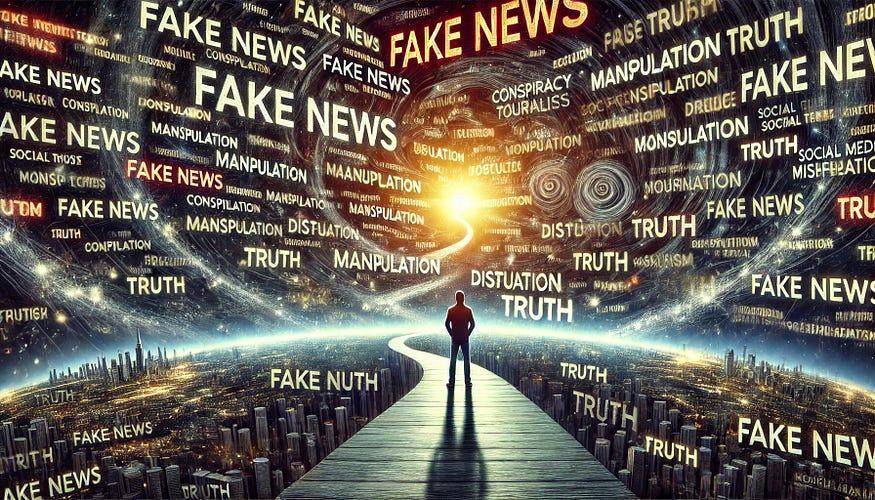
So, who gains from this kind of journalism? Who benefits from news that works like a “bazooka aimed at the world”? Those who don’t mind shouldering the bazooka themselves. They win…
“When everything and everyone is presented as flawed, there is no point in making distinctions on this matter, which works in favour of those who are the most extremely flawed. Courtesy, civility, and reasonable proposals are no longer material for front pages, which instead give voice to those who specialise in the art of destruction.” — Thomas E. Patterson, Professor of Government and Journalism at Harvard.
The Alternative to Cynicism: A Journalism that Proposes Solutions
Having analyzed the current situation and the pathologies of the dominant journalistic approach, it is time to turn to the solution. If cynical, negative, and doom-laden journalism drives citizens away, distorts reality, undermines trust, institutions, and democracy — then what is the alternative?
A journalism that presents only positive news? A journalism that sugarcoats the world, as if everything were solved? A journalism that avoids conflict and acts as an uncritical supporter of those in power?
The answer is clear: No.
Such an approach would be equally problematic. Reality is complex and the world faces huge challenges: climate crisis, corruption, inequalities, social and political tensions. Journalism must neither ignore them nor indulge in catastrophe-mongering.
Healthy journalism recognizes the problems but does not stop there. It also presents the solutions, the people, and the initiatives that make a difference.
The alternative is not naïve optimism, but Constructive Journalism — an approach that focuses not only on what is going wrong but also on what could go right.
Journalism does not have the sole duty of uncovering scandals, conflicts, and crises. It also has the responsibility to shed light on the possibilities for change, to highlight examples that inspire, and to deepen the public’s understanding of problems in a way that leads to action, not paralysis.
This is Constructive Journalism. And this is the solution — not only for the crisis of trust and the financial troubles facing the media today but also for democracy itself, which depends on an informed, active, and well-informed civil society.
───────────────────────────────────────────────
This was also the reason why we launched Orthos Logos, seeing it as our duty to forge a more useful journalism, hoping that others, gradually at least, will understand and follow this example. For this reason too, we contributed to the founding of the Hellenic Institute of Constructive Journalism, aiming to introduce and spread, in Greece and beyond, to experts and lay people alike, a journalism that can ultimately inspire and cultivate trust and hope. And as research shows, when people believe that “solutions exist,” that the world can get better, they are empowered to feel they can make a difference — and to participate actively towards a better tomorrow.
───────────────────────────────────────────────
A Journalism that Builds Hope
The greatest challenge for journalism today is to remain relevant and useful. It is not enough to be merely critical; it must also be creative. Journalism has immense power in shaping how people perceive the world. If the stories we tell focus only on the negative, then we do not merely inform — we help spread despair and hopelessness. Yet journalism cannot have as its sole role the chronicling of decline. Exercising oversight and criticism towards power cannot be limited to highlighting the world’s distortions. Hope is not the opposite of criticism; it is its prerequisite. As it has been aptly put:
Hope without critical thinking is naivety, but critical thinking without hope is cynicism.
So the question is: What kind of journalism do we want?
A journalism that presents only destruction, leaving citizens with a sense of futility? Or a journalism that acknowledges problems while also highlighting solutions?
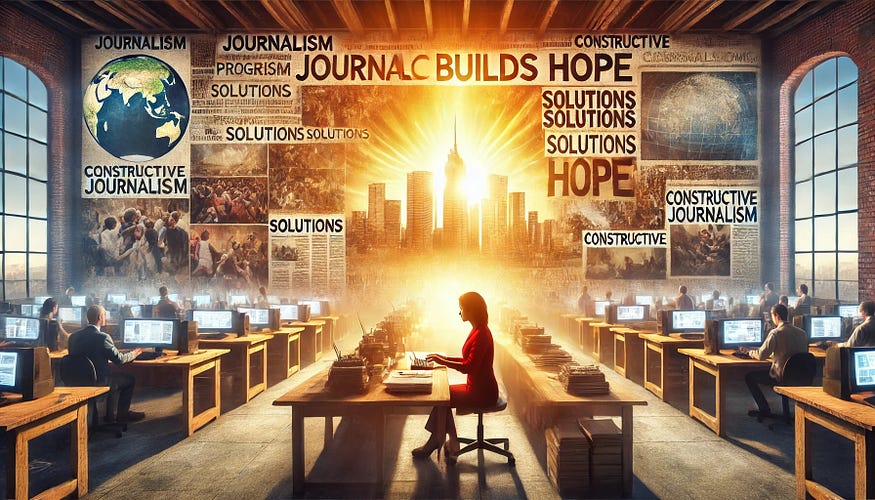
Constructive Journalism teaches that a journalist must provide citizens with a fair, accurate, and coherent picture of the world — without exaggerating the negative and the sensational. This approach does not avoid criticism and scrutiny. On the contrary, it aims to equip the public with the tools they need to develop critical thinking, to act, and to participate, rather than feel powerless and disconnected. Because the greatest strength of journalism is not merely its ability to expose scandals or to “bring down” a politician. Its real power lies in how it shapes our perception of the world. If journalists talk only about what goes wrong, they cultivate the impression that the world is doomed. But the world is not only crises and problems. It is full of people working to make it better. Full of ideas, initiatives, and solutions that deserve to be highlighted.
The duty of journalism is not to beautify reality but to provide a complete and fair picture of the world. It must highlight solutions with the same emphasis it gives to problems, illuminating not only the crises but also the ways out. And since “problems scream while solutions whisper,” it is our responsibility, as journalists, to amplify these “whispered” solutions, giving them the space and attention they deserve — not to create illusions, but to offer hope and perspective.
Hope is such an underrated power. And it is power — not just an emotion. It is not static. It is not something we either have or do not have. It is a bit like a muscle: it can be strengthened, it can be built. And the way it is built is essentially the combination of two things: the belief that the future can be better, and the belief that our actions can make a difference.
To have hope, we must believe that the future can improve. To maintain hope, we must have proof that change is possible. That is why storytelling that highlights solutions is so powerful. It does not merely offer a more complete picture of the world but helps strengthen the belief that progress is possible, that change can happen, that actions matter.
What Now?
The choice is before us. If we want journalism to be useful, credible, and relevant, we must break free from the vicious cycle of cynicism and pessimism.
Constructive Journalism is not just an alternative — it is a necessity.
And if we want news that truly contributes to a healthier, more democratic society, we must take on this responsibility.
So the question is not whether we can change. It is when we will decide to do so…

